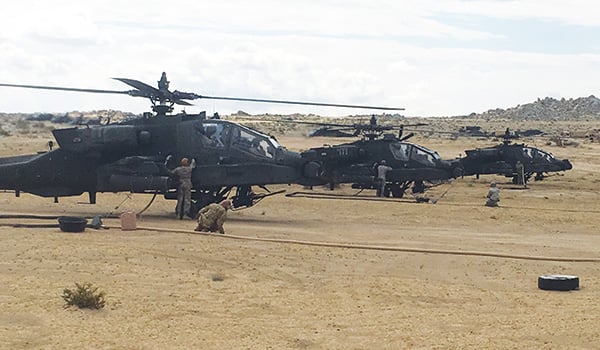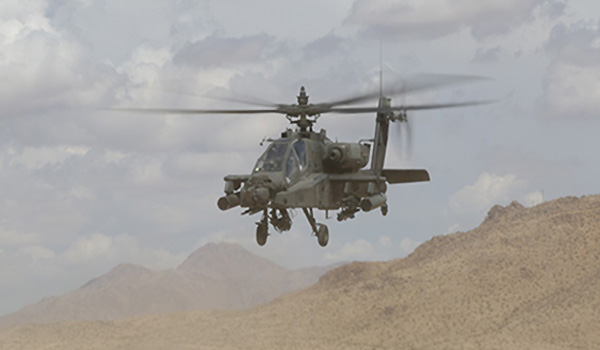
Eagle Team Update / By LTC Zachary Mundell: The Eagle Team at the National Training Center (NTC) continues to focus on providing world-class training to aviation professionals. Our charter remains to coach, teach and mentor aviation task forces on the application and execution of joint and multinational decisive action aviation operations supporting unified land operations in a realistic, competitive environment. Our aim is to improve the warfighting skills, integration, and effectiveness of multi-functional aviation task forces as they prepare for combat. Every unit that trains at the NTC will leave better prepared for the reality of combat in today’s increasingly complex environment.

Soldiers from Co. E, 3-501 AVN conduct refueling and rearming operations at TAA Apocalypse during NTC Rotation 16-05./U.S. ARMY PHOTO BY CPT JACOB RYKKEN, EAGLE TEAM FSC TRAINER
Our team is currently focused on several initiatives impacting the greater Army Aviation community in the Decisive Action Training Environment (DATE): reshaping the command relationships of rotational units to more closely resemble how we will fight; improving the air defense threat to include similar capabilities to those specified in DATE 2.0 in order to provide aviators a realistic threat environment to maneuver against; enhancing the training outcomes for units by fully incorporating smaller-scale, free-play training exercises (Downed Aircraft Recovery (DART), Personnel Recovery (PR), etc.) into the rotational design.
Adjusting Task Organization
The NTC’s charter is to train brigade combat teams (BCT) for operations in the DATE. The NTC accomplishes this through a robust, complex training facility infrastructure, scenario design and a professional opposing force that replicates both conventional and unconventional threats. Although aviation task forces receive world-class training at the NTC, they have been largely incorporated as an enabler element during rotations and have been placed in direct support (DS) to the training BCT. In April 2016 we initiated a new construct in which the aviation task force is task organized under the division for the duration of the exercise. Reflecting the most likely task organization construct aviation units will experience in a combat situation, this adjustment also allows the division and Eagle Team to ensure that aviation task forces are fully trained in their core competencies while at the NTC.

Soldiers from 3-501 AVN conduct a rehearsal for their tactical road march during NTC Rotation 16-05./U.S. ARMY EAGLE TEAM PHOTO
Units that participate in future rotations at the NTC should expect to execute both combined arms maneuver (CAM) and wide area security (WAS) missions that cover the full menu of Army Aviation’s core competencies. Aviation task forces will be tasked to conduct missions in support of both the division and the rotational BCT. With an increased emphasis on deliberate attack and air assault missions driven at the division-level, units should expect to employ companies and platoons in maneuver through the full range of operations. This includes an increase in missions to include deliberate attacks against enemy armor and artillery formations, air assaults to seize key terrain, and screen/guard missions along the division flank.
Enhanced Threat Capabilities
With the emergence and sustainment of the Global War on Terror, the focus of Army Aviation’s threat training shifted from conventional enemy forces to unconventional, smaller-scale threats. Our combat training centers (CTCs) quickly followed suit, developing new infrastructure (including towns and forward operating bases (FOBs)) and adjusting opposing force tactics to fit the reality that our forces would likely face in Operations Enduring Freedom and Iraqi Freedom. A side-effect of this shift was the neglect of the enemy air defense (ADA) threat, except for a few aging systems that remain in the 11th Armored Cavalry Regiment (ACR) inventory. Unfortunately, with this shift came an elimination of the ADA unit that once was organic to 11th ACR, including the loss of all ADA personnel. The result has been a loss of threat capabilities at the NTC and limited ability to replicate current threat ADA capabilities.

An AH-64 from Co. C, 1-501 Attack Reconnaissance Battalion observes enemy movement while conducting reconnaissance operations during NTC Rotation 16-05./U.S. ARMY EAGLE TEAM PHOTO
The Eagle Team has been actively working with 11th ACR, PEO-STRI and other Army agencies to recreate this threat to the greatest extent possible. In addition, aviation units training at the NTC must deploy will all aircraft survivability equipment (ASE) installed and functional in order to test those systems and train personnel on how those systems mitigate the ADA threat. The Eagle Team stands fully committed to rebuilding this threat capability at the NTC in order to provide the most realistic training possible for Army aviators.
Enhanced Micro Exercise Incorporation
Over the past year and a half the NTC has shifted the standard rotational design from including situational training exercise (STX) lanes at the beginning to incorporating full force-on-force operations from start to end. This has resulted in enhanced training at the BCT and TF level and a de-emphasis on small unit training. Whereas in the past aviation task forces could expect to have five days focused on team and platoon skills, those micro training events must now be scripted into the overall rotational design, which fluctuates according to actions and reactions of both friendly and enemy forces.
Although we no longer run a dedicated PR lane, the team has developed mobile lanes that move with the overall rotational scenario in order to focus on opportunity training. Aviators who are shot down by enemy fire should expect to escape and evade through enemy territory. DART exercises now focus almost exclusively on the same training opportunities wherein aircraft have been shot down by enemy forces and must be recovered. Attacks against the Aviation tactical assembly area (TAA) are no longer scripted by the team, but develop according to the flow of the rotation. Units which choose not to secure their perimeters and that pose easy targets will be attacked frequently, as Aviation formations pose significant payoff targets for enemy forces. Those units that portray a formidable target are less likely to experience the same attacks.
Tips for Aviation Units
While the list of skills and tasks required to succeed at the NTC is too exhaustive to cover in an article, we would advise units to focus on mastering basic Soldier and unit skills during home station training. All of them will be tested in one way or another at the NTC. In addition, units should train on simultaneous, overlapping missions. For example, task forces must be able to manage a deliberate attack mission, air assault planning, a MEDEVAC mission and convoy operations simultaneously. Task forces should also focus shifting from de-centralized planning to centralized planning at the task force level and decentralized execution by companies and platoons. Many units struggle due to unfamiliarity or not using their own standing operating procedures (SOPs). We recommend that task forces organize early and use their SOPs in their pre-rotational training to build familiarity and competence across the organization. Finally, commanders should evaluate their air mission commander (AMC) training programs to ensure AMCs are as prepared as platoon leaders and company/troop commanders to operationally fight their formations. AMC proficiency must go beyond masterful aircraft employment to expert tactical maneuver of platoon and company formations.
Conclusion
As the Army continues to refine Aviation doctrine, the CTCs carry a unique charter to provide feedback on current tactics, techniques and procedures (TTPs) and the application of doctrine by Aviation units. The Eagle Team regularly participates in round table discussions with leaders from the other CTCs to share observations, insights and lessons learned (OIL). Over the past year we have assisted with doctrinal reviews and course formulation for the Aviation school house, including the Captains Career Course and the Air Cavalry Leader’s Course at Fort Rucker, AL.
We have also launched new initiatives in conjunction with Operations Group at the NTC to regularly publish OIL in the Joint Lessons Learned Information System (JLLIS) as well as our professional journal Aviation Digest and ARMYAVIATION magazine. The purpose of all of these efforts is to ensure that the force is fully informed about challenges units are experiencing and to fully develop our warfighting capabilities as a force. The Eagle Team is proud of its heritage of training America’s aviators and we stand ready to continue this tradition into the future as we confront our nation’s emerging threats.
Train the Force!
LTC Zachary Mundell is the senior aviation operations trainer with Eagle Team, National Training Center, Fort Irwin, CA.










